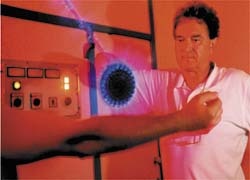HF shower to treat pain and depression
In the first six months of 2004, over 17,000 people sought help and advice from the German Pain Union (Deutsche Schmerzliga), which demonstrates the high number of people, in Germany alone, who have failed to find a therapy that can alleviate recurrent or chronic pains

Anja Behringer reports on a high-frequency pain therapy applied at the out-patient clinic for electro-physical medicine and hydrotherapy (Ambulatorium für elektrophysikalische Medizin und Hydrotherapie) Nuhr-Zentrum Senftenberg, near Vienna, and used on patients from all over Europe for over half a century. ‘This treatment,’ she said, ‘has a long and successful history, although it is less known for its pain-relieving potential. There are procedures to improve blood circulation and to stimulate muscles. With rheumatic conditions, however, electro therapy is primarily used to relieve pain.’ Could this therapy also have evolved to become a treatment for depression?
Over 100 years ago, Heinrich Hertz conducted ground-breaking research on electromagnetic waves. In 1891, Nikola Tesla, a Serbian-American electrical engineer, had managed to build a high-frequency transformer, and a year later, French physiologist Jacques-Arsene d’ Arsonval suggested using high-frequency (HF) currents for medical purposes. Due to high voltage, these ‘Arsonval currents’ could be showered on patients in long spark discharges, without causing harm.
In the 1950s, Austrian physician Dr Otto Nuhr (1912 - 1989), with a founder-member of the Austrian firm Test-Fuchs, developed and modified this therapy, by creating the necessary instruments for its application. (Test-Fuchs specialized in the production of precision instruments for aviation).
According to Dr Nuhr, for a local application of HF therapy a brush-shaped electrode has to be positioned opposite the body region to be treated. The electrode is connected to the single pole of the secondary coil - the Tesla coil. The brush-shaped electrode emits a light generated by glow discharge. When tension is increased, or the distance between the brush and patient is decreased, that glow becomes a brush light, which becomes electric sparks.
The specific effects of these high-frequency currents are deepening of respiration, bradycardia, reduction of heart shadow, increased systole, and an initial increase in blood pressure, followed by a decrease due to the reduction of peripheral resistance. Dr Nuhr said that HF therapy particularly has positive effects on superordinated regulation mechanisms. Consequently, this therapy is applied when patients suffer spinal or disc conditions, rheumatism, as well as infections, arterial problems, stress, and general deterioration of physical performance.
Depression
A recent study indicated a particularly striking effect of the high-voltage capacitor discharge therapy. According to Professor Wolfgang Marktl, director of the Ludwig-Boltzmann-Instituts, Austria, and physiologist at the Institute for Medical Physiology and Environmental Physiology, University of Vienna, the therapy affects the adrenal gland in such a way that, at night, lesser quantities of the hormones cortisol and adrenaline are discharged. This has resulted not only in improved blood circulation but also in significantly lowered values on the depression scale (VAS). Research indicates that these positive results last up to a year.
01.03.2005





